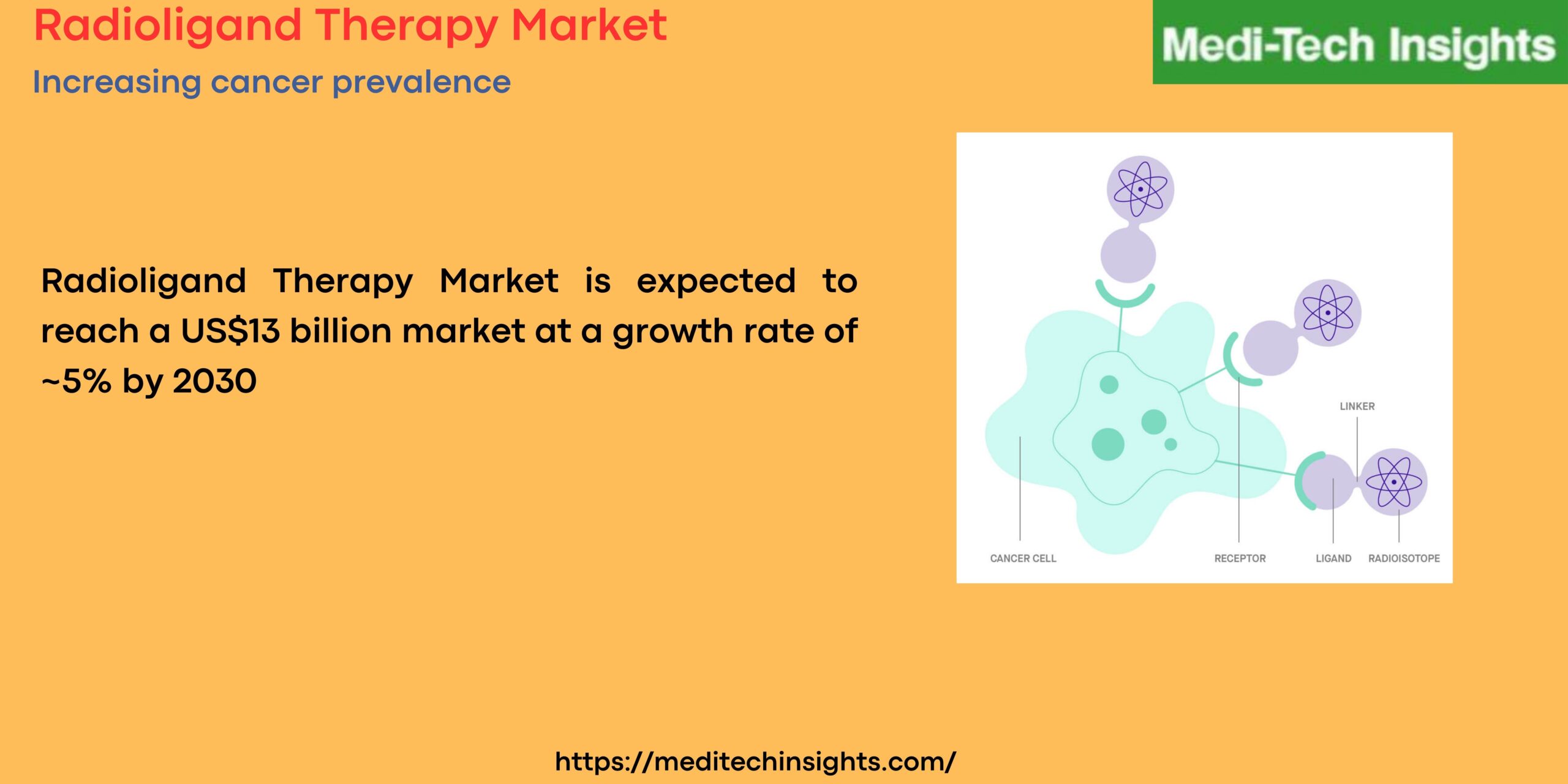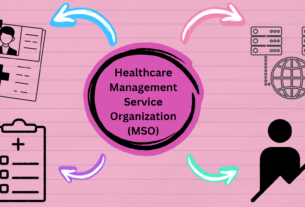Increasing cancer prevalence, including prostate cancer and neuroendocrine tumors, advances in nuclear medicine in the field of radiopharmaceutical development, a growing geriatric population, increased awareness and understanding of radiotherapy isotopes, and an increase in clinical research and trial activities for developing new product pipelines are some of the key factors driving the radioligand therapy market.
Radioligand therapy is a type of precision nuclear medicine used to treat advanced cancer patients. Radioligand therapy, also known as radionuclide or radiopharmaceutical therapy, is a type of cancer treatment in which radiation is delivered directly to cancer cells. By attaching a radioisotope to a targeting molecule that delivers radiation directly to cancer cells, radioligand treatment can enable precision cancer targeting while reducing the impact on healthy tissue.
To learn more about the research, fill out a quick inquiry for a sample report: https://meditechinsights.com/radioligand-therapy-market/request-sample/
A radioisotope, which produces radiation that kills cells, and a targeted ligand, a chemical that binds to particular markers on cancer cells, are the two main components of radioligand treatments. The radioactive component has an extremely short half-life, which is the amount of time it takes for radioactivity to fall by 50%. Once the radioactivity decays, it can no longer efficiently kill cancer cells, implying that radioligand treatment has a limited window of viability. The medicine must reach patients within a few days of being packed and ready to ship. Because of the short time window for delivery, these medications are frequently manufactured in single-patient dosages.
A Clinical Trial Advancement for Therapeutic Radiopharmaceutical Pipelines Will Drive Radioligand Therapy Market Growth
In recent years, oncology research has made great strides. Radioligand treatments have the potential to change oncology’s standard of care. Clinical studies are essential for determining the efficacy and safety of therapeutic radiopharmaceuticals. The prospective consequence aids researchers in treating numerous cancer kinds and disorders, as well as attracting pharmaceutical company funding. As a result, advances in clinical trials for therapeutic radiopharmaceutical pipelines have the potential to considerably increase field market expansion. For instance,
- In December 2023, Lantheus Holdings, Inc.and POINT Biopharma Global Inc. announced statistically significant topline results from the pivotal phase 3 SPLASH study evaluating the efficacy and safety of 177Lu-PNT2002, a prostate-specific membrane antigen (PSMA)-targeted radioligand therapy (RLT), in patients with metastatic castration-resistant prostate cancer (mCRPC) after progression on an androgen receptor pathway inhibitor (ARPI).
- In May 2023, RadioMedixand Orano Med announced that the last patient had been dosed in the Phase II trial of the targeted alpha emitter therapy, 212Pb-DOTAMTATE (AlphaMedix). This trial is being conducted to evaluate the safety and effectiveness of AlphaMedix in peptide receptor radionuclide therapy (PRRT) of naive patients with somatostatin receptor-expressing neuroendocrine tumors (NET), regardless of the location of the primary tumor.
Radioligand Therapy’s Emerging Applications in Neuroendocrine Neoplasms, Prostate Cancer, and Non-cancerous Conditions Increase Radioligand Therapy Market Demand
Cancer care has advanced in many areas, including advancements in treatment and therapy, but for many patients, effective therapeutic choices remain unavailable. The most recent radioligand applications focus on NETs and bone metastases in mCRPC, with research in many other cancer and non-cancer disorders underway. Radioligand treatment directs radiation to certain types of cells and is progressively developing as an important pillar in cancer care. Among the new uses of radioligand treatment are:
- Neuroendocrine Neoplasms (NETs):Neuroendocrine malignancies (NECs) are a kind of cancer that includes both neuroendocrine tumors (NETs) and neuroendocrine carcinomas (NECs). Radioligand therapy has been shown to be effective in treating neuroendocrine tumors (NETs), which emerge from neuroendocrine cells and can occur in a variety of organs. Radioligand treatment increases progression-free survival and disease management while also shrinking tumor size. For instance,
- In September 2023, The Phase III NETTER-2 study with Lutather (INN: lutetium (177Lu) oxodotreotide / USAN: lutetium Lu 177 dotatate) attained its primary goal, according to Novartis. Lutathera in combination with long-acting octreotide improved progression-free survival (PFS) in patients with newly diagnosed somatostatin receptor (SSTR)-positive, Grade 2 and 3 advanced gastroenteropancreatic neuroendocrine tumors (GEP-NETs) compared to high-dose long-acting octreotide alone.
- Prostate Cancer:Prostate cancer is the most frequent disease in males and the main cause of cancer-related deaths globally. PSMA radioligand treatment using urea-based medicines and a- and -particle emitting radionuclides such as Lutetium-177, Actinium-225, Thorium-227, Terbium-161, Lead 212, and others has been discovered as a viable strategy for patients with hormone-sensitive and castrate-resistant prostate cancer. For instance,
- In October 2023, At the 2023 European Society of Medical Oncology (ESMO) Congress, Novartis released findings from the Phase III PSMAfore study. PluvictoTM (lutetium (177Lu) vipivotide tetraxetan) met its primary endpoint with a clinically meaningful and statistically significant benefit in radiographic progression-free survival (rPFS) in patients with PSMA-positive metastatic castration-resistant prostate cancer (mCRPC) after treatment with androgen receptor pathway inhibitor (ARPI) therapy, compared to a change in ARPI1 expression.
- Non-cancerous Conditions:The primary focus of radioligand therapy is on cancer treatment, researchers are also exploring how the approach could be utilized in other non-cancerous conditions. For example:
- Inflammatory Conditions: Radioligand therapy has been investigated for its anti-inflammatory properties, and there is interest in its potential application in diseases with an inflammatory component.
- Arthritis: Some preclinical studies have explored the use of Radioligand in inflammatory joint conditions, such as rheumatoid arthritis. Research in this area is in the early stages.
The approach is also currently being explored both as a standalone treatment approach and in combination with other treatment modalities.
Radioligand Market – Key Constraints
The radioligand treatment market is confronted with a number of obstacles and constraints. The initial and continuing expenditures of the therapy might be substantial. Due to the scarcity of radioligand therapy-trained healthcare workers, the strategy is limited to a restricted number of specialized centers. Radioligand regulatory frameworks must also develop to accommodate this new therapy technique. This may have an impact on who and how therapy is delivered. Radioligand therapy is a targeted kind of cancer treatment that is only viable for a few days after it is created, therefore further policy changes in terms of radioisotope supply and nuclear waste are required. Finally, the scarcity of meaningful clinical and economic data on radioligand treatment presents difficulties.
North America controls the majority of the Global Radioligand Therapy market
North America has emerged as the global leader in radioligand treatment. The area is seeing significant market expansion, which is being driven by rigorous laws controlling the healthcare and pharmaceutical industries. Increasing investments from public and private funding and clinical progression for many radioligand therapy products, growing patient awareness about the benefits of radioligand therapy, and an increase in the number of cancer patients in the United States all contribute significantly to market growth. During the predicted period, the European area is likely to have profitable growth. The growing initiative by the government to reduce the cancer burden, growing healthcare infrastructure, increased awareness about the availability of various therapies, and an increase in cancer prevalence present significant growth opportunities for the radioligand therapy market in the region.
Radioligand Market – Competitive Landscape
The top market players in the radioligand therapy market include Novartis International AG, POINT Biopharma Global Inc., Fusion Pharma, Orano Med, Clovis Oncology, Telix Pharmaceuticals, Lantheus Holdings, Inc., Bayer AG, Eli Lilly, Molecular Partners, ITM Isotope Technologies Munich SE, Curium Pharma, Precirix, and Radio Medix, among others.
Organic and Inorganic Growth Strategies Adopted by Players to Establish Their Foothold in the Radioligand Therapy Market
Players operating in this market are adopting organic and inorganic growth strategies such as collaborations, and acquisitions to garner market share. For instance,
- In November 2023, Orano Med, a pioneer in targeted alpha therapy, and 48Hour Discovery, a novel peptide discovery platform company, announced their strategic collaboration to advance cancer treatment through radioligand discovery and development.
- In October 2023, Eli Lillyand POINT Biopharma Global, Inc. announced a definitive agreement for Lilly to acquire POINT, a radiopharmaceutical company with a pipeline of clinical and preclinical-stage radioligand therapies in development for the treatment of cancer.
- In September 2023, POINT Biopharma Global Inc. and Athebio AG announced a collaboration and license agreement to develop and commercialize DARPin-targeted radioligands (“Radio-DARPins”).
Radioligand treatment is a technological advancement from imaging to therapy. The market is expected to expand further as pharmaceutical companies increase their investments in the development and commercialization of radioligand therapies, as radioligand therapy applications expand, imaging technologies advance, and players pursue aggressive organic and inorganic growth strategies.
Get Detailed Insights on the Radioligand Therapy Market @ https://meditechinsights.com/radioligand-therapy-market/
About Medi-Tech Insights
Medi-Tech Insights is a healthcare-focused business research & insights firm. Our clients include Fortune 500 companies, blue-chip investors & hyper-growth start-ups. We have successfully completed 100+ projects in Digital Health, Healthcare IT, Medical Technology, Medical Devices & Pharma Services.
Contact:
Ruta Halde
Associate, Medi-Tech Insights
+32 498 86 80 79
info@meditechinsights.com


